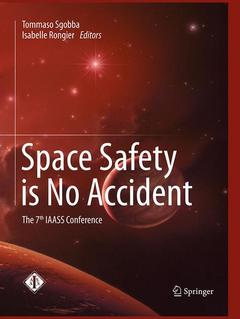Space Safety is No Accident, Softcover reprint of the original 1st ed. 2015 The 7th IAASS Conference
Coordonnateurs : Sgobba Tommaso, Rongier Isabelle

Includes the proceedings from the 7th IAASS Conference, "Space Safety is No Accident," held in Friedrichshafen, Germany, in October 2014.
The 7th IAASS Conference, ?Space Safety is No Accident? is an invitation to reflect and exchange information on a number of topics in space safety and sustainability of national and international interest. The conference is also a forum to promote mutual understanding, trust and the widest possible international cooperation in such matters. The once exclusive ?club? of nations with autonomous sub-orbital and orbital space access capabilities is becoming crowded with fresh and ambitious new entrants. New commercial spaceports are starting operations and others are being built.
In the manned spaceflight arena a commercial market is becoming a tangible reality with suborbital spaceflights and government use of commercial services for cargo and crew transportation to orbit. Besides the national ambitions in space, the international cooperation both civil and commercial is also gaining momentum. In the meantime robotic space exploration will accelerate and with it the need to internationally better regulate the usage of nuclear power sources. Space-bound systems and aviation traffic will share more and more a crowded airspace, while aviation will increasingly rely on space-based safety-critical services. Finally, most nations own nowadays space assets, mainly satellites of various kinds and purposes, which are under the constant threat of collision with other spacecraft and with the ever increasing number of space debris. Awareness is increasing internationally (as solemnly declared since decades in space treaties) that space is a mankind asset and that we all have the duty of caring for it. Without proactive and courageous international initiatives to organize space, we risk to negate access and use of space to future generations.
Tommaso Sgobba holds an M.S. in aeronautical engineering from the Polytechnic Institute of Turin, where he was professor of space system safety from 1999-2011. Currently, he is President Emeritus and co-founder of the International Association for the Advancement of Space Safety (IAASS), which gathers the top space safety experts worldwide. He is also Board Member of the US-based International Space Safety Foundation (ISSF). Until October 2012, Sgobba was responsible for flight safety at the European Space Agency (ESA), including human-rated systems, spacecraft re-entries, space debris, use of nuclear power sources and planetary protection. He joined ESA in 1989, after 13 years in the aeronautical industry. Initially he supported the developments of the Ariane 5 launcher, several earth observation and meteorological satellites and the early phase of the Hermes spaceplane. Later he became product assurance and safety manager for all European manned missions on Shuttle, MIR station and for the European research facilities for the International Space Station (ISS).
During his long and close cooperation with the NASA Shuttle/ISS Payload Safety Review Panel, Sgobba developed at ESA the safety technical and organizational capabilities that eventually led in 2002 to the establishment of the first ESA formal safety review panel and first International Partner ISS Payload Safety Review Panel. He was also instrumental in setting up the ESA Re-entry Safety Review Panel and in organizing the first ESA scientific observation campaign of a destructively re-entering spacecraft (ATV- Jules Verne). Sgobba received the NASA recognition for outstanding contribution to the International Space Station in 2004 and the prestigious NASA Space Flight Awareness (SFA) Award.
Sgobba has published several articles and papers on space safety, and has co-edited with two NASA colleagues the text book “Safety Design for Space Systems,” published in 2009 by Elsevier, and “The Nee
Includes the proceedings from the 7th IAASS Conference, "Space Safety is No Accident," held in Friedrichshafen, Germany, in October 2014
Topics of papers include launch and re-entry safety, safety design of manned space systems, space debris removal and space traffic management
Date de parution : 08-2016
Ouvrage de 640 p.
21x27.9 cm
Date de parution : 10-2015
Ouvrage de 640 p.
21x27.9 cm



